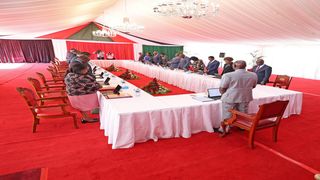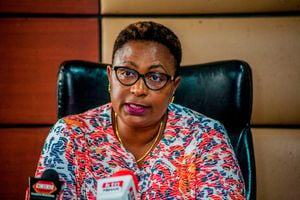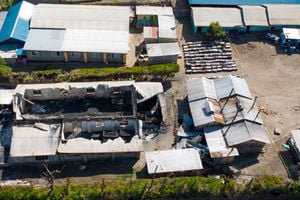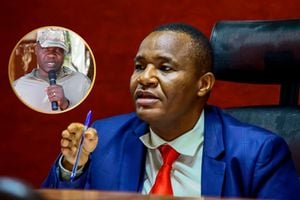
President William Ruto chairs a Cabinet meeting at State Lodge, Kisumu on October 9, 2023
| PCSOur Columnists
Premium
The inner workings of politics and power in Kenya
Political developments in Kenya are fascinating to watch, especially people not familiar with how the country works.
Reading through the media gives the impression of a country that is always on a political campaign mode even when elections are concluded or several years away. And it does not matter whether at the national or sub-national (county) level.
It is all the same. At the county level, relations between the county governors and their Members of County Assemblies (MCAs) conflictual. There is political drama almost all the time.
At the national level, media coverage has been about internal conflicts and lack of coherence within the ruling Kenya Kwanza coalition.
Some have even suggested that there is a rift between President William Ruto and Deputy President Rigathi Gachagua. The rift is attributed to the President’s agreeing have dialogue with the leader of the opposition, Raila Odinga, who mobilised public protests against the government and disrupted economic activities for a while.
A good understanding of why political conflicts remain endemic in Kenya requires one to understand how the country works. And this is also true of many countries where politics is driven by elite interests. Kenya’s politics has several features.
First, our elections are very competitive. Whether presidential or governor or MCAs, the competition to win these seats is intense and, for some, it is a ‘do-or-die’ contest for some leaders. The ‘winner-takes-all’ nature of our politics make this possible. Those who lose, sometimes lose lifetime investments.
Secondly, violent conflicts erupt around election time, more so after the election. These conflicts have ethno-regional dimension because of how political parties mobilise support. How the losing presidential candidate interpret and perceive their loss always causes violence. There is no presidential candidate loser who agrees that the election is free and credible.
Electoral technology
They are belligerent and often believe they won, or something went wrong somewhere with their votes. This belligerence is absent on the part of the governors, MCAs, and other candidates even though six elections are held the same day, same balloting booth, and same polling station.
In fact, the number of petitions in the court for these lower level seats has reduced, especially because many losers have no evidence to table to explain their loss.
Although in the past losers would table evidence on how the Independent Elections and Boundaries Commission (IEBC) applied rules in a biased manner that led to their loss, not many can adduce such evidence any more. With increased use of electoral technology, losers are not able to prove that technology affected the outcome.
It is, therefore, strange that demand for the audit of 2022 elections has not focused on the audit of the six elections conducted – Presidential, Senate, National Assembly, Women Representative, Governor, and Member of County Assembly. An effect audit can bring out any problems by focusing on voting and tallying of results of each of these six elections and in each polling station to verify the outcome. Any difference between total number of votes per seat would be a ringtone of trouble.
The third element of Kenya’s politics is post-election bargains and pacts by political elites. Whether in ruling coalitions or opposition parties, political elites in Kenya have one thing in common: Politics is about personal benefits.
How to advance personal interests and how to ensure institutions serve their interests remain their focus. On account of this, those who win the election often begin by reconfiguring institutions – including economic policies through political business cycles – to effectively serve them. This may include altering governance of institutions to help in implementation of their new policy objectives.
Agreed to work together
After elections, losers are out there excluded from the benefits of politics. Sometimes the losers have what it takes to disrupt policy objectives of the winning coalition or political party. They may have resources, organisational ability, and ethnic and other social aspects of support that they can use to effectively mobilise against the winning political party.
The winner therefore is usually minded to pay attention to those groups and individuals who lose especially if they have resources and organisational capability to disrupt their programmes. Let us put this in context.
In 2017, Raila Odinga lost the election to President Uhuru Kenyatta and in March 2018, they shook hands and agreed to work together.
President Kenyatta was doing this mindful of the fact that Odinga’s public protests had the potential to disrupt his economic policy plans. Their handshake went further than this. It led to their establishing a broad based coalition, Azimio party, to compete against the then-Deputy President William Ruto’s new coalition.
Unfortunately, even with the support of the government and President Kenyatta and his Mount Kenya moneyed elites, Odinga lost. The Supreme Court upheld the results. But this did not stop Odinga and allied parties from organising protests against the outcome of the elections. In line with the characterisitics of Kenya’s politics, President Ruto and Odinga, had to have a tacit agreement on how to end the hostilities.
It does not matter who approached who first. What matters is that President Ruto has to be mindful about powerful groups that have ability to disrupt his policies. Also it matters that Odinga cannot stay outside without political benefits.
Again in line with inner working of Kenya’s politics, there must be a way of generating benefits for losers to ensure stability of the system. This is what stabilises Kenya. For this reason, internal conflicts within Kenya Kwanza are not anything new.
Neither are the internal conflicts within Azimio anything new. All of them will continue changing until the time of another election. Some will remain inside and others will move out to create room for those outside.
It is noteworthy that these dynamics stabilise the system and allow for implementation of development policies. These dynamics end up delivering to all powerful groups and individuals a certain level of benefit acceptable to them. This prevents them from assaulting those in power. When they benefit, it allows those in power to impose their vision of policies without opposition.
- Prof Kanyinga is based at the Institute for Development Studies (IDS), University of Nairobi, [email protected], @karutikk





